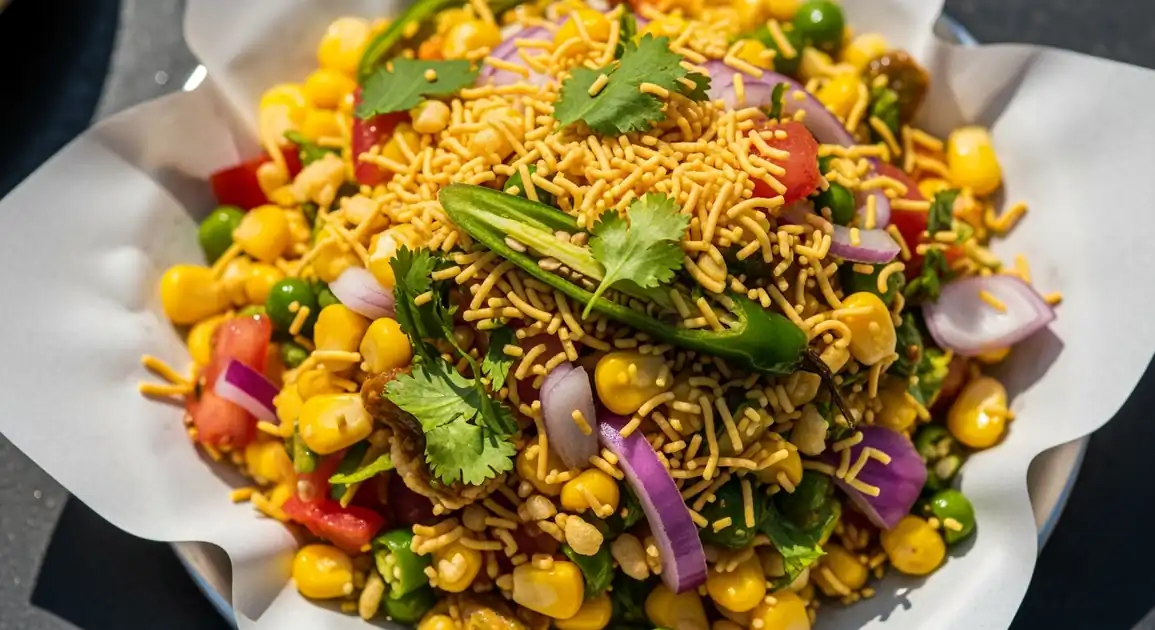Corn Bhel
Corn Bhel / मकई भेल (Makai Bhel)

Description
Corn Bhel is a popular street food snack found across India, especially in major cities and urban centers. While strongly associated with Mumbai's chaat culture, variations can be found in food stalls, markets, and beaches nationwide, often adapted slightly to local tastes.
Dietary Information
Serving information
Serving style
Served immediately after mixing, typically in disposable paper cones, paper plates, or small steel plates ('dona'). Eaten with a small plastic or wooden spoon, or sometimes scooped with papdi (flat crackers, if provided).
Quick facts
Peak hours are typically late afternoon and evening (approx. 4 PM - 10 PM). Mall counters follow mall timings.
Safety Tips
What to Look For
-
Fresh, bright-looking ingredients
Corn, onions, tomatoes, coriander should look fresh and vibrant, not wilted, bruised, or discolored.
-
Clean stall and utensils
Observe the cleanliness of the vendor's cart, cutting surfaces, knives, mixing bowls, and serving spoons/plates.
-
Vendor uses clean hands, gloves, or spoons
Ensure the vendor practices good hygiene when handling ingredients, especially after touching money.
-
Chutneys look fresh and properly stored
Chutneys should be covered and look vibrant. Avoid watery or suspiciously colored chutneys. Check source of water if visible.
-
High customer turnover
A busy stall generally indicates fresher ingredients that are quickly consumed.
-
Sev looks crisp and stored in airtight container
Ensures the sev retains its crunch and hasn't gone stale or absorbed moisture.
What to avoid
-
Wilted, dull, or old-looking ingredients
Increases risk of spoilage and indicates poor quality.
-
Presence of flies around ingredients or stall
Major hygiene red flag, indicates potential contamination.
-
Dirty water source or unclean water used for chutneys
Contaminated water is a primary source of street food illness. Be cautious if cleanliness looks dubious.
-
Pre-mixed bhel sitting out for long periods
The mixture becomes soggy, losing texture and potentially harboring bacteria. Always prefer freshly mixed.
-
Vendor with poor personal hygiene
Avoid vendors who don't wash hands or handle food improperly.
Price information
Price range
Budget tips
- Prices are lowest at simple street stalls (30-50 INR).
- Beach stalls or food courts might charge slightly more (50-80 INR).
- Prices vary based on city and location within the city.
- Basic versions are cheaper than those with cheese or other additions.
Value indicators
- Generous portion size.
- Fresh ingredients.
- Good balance of sweet, tangy, spicy flavors.
- Plenty of crispy sev topping.
Where to Find This Dish
Street Corners & Markets
Common sight in busy market areas or popular street food hubs.
Local markets, Busy junctions, Outside colleges
Evening
Beaches & Parks
Popular snack option in recreational areas.
Public beaches, Parks with food stalls
Evening, Weekends
Food Courts & Malls
Chaat counters often include Corn Bhel.
Shopping malls, Multiplexes
All day (mall hours)
Vendor Tips
- Observe the vendor's mixing technique – should be quick and thorough.
- Specify spice preference clearly.
- Ask for 'Jain' version if you avoid onion/garlic (though chutneys might still contain garlic).
How to Order
Regional Variations
-
Sweet Corn Bhel
(Sweet Corn Bhel)
Uses American sweet corn kernels, which are naturally sweeter and often larger.
-
Masala Corn Bhel
(Masala Corn Bhel)
May include additional spices like red chili powder or garam masala for extra heat and flavor.
-
Cheese Corn Bhel
(Cheese Corn Bhel)
A modern fusion variation where grated processed cheese is added on top.
-
Corn Bhel with Peanuts
(Corn Bhel with Singhdana)
Includes roasted peanuts ('singhdana') for extra crunch and nutty flavor.
-
Corn Bhel with Puffed Rice
(Corn Murmura Bhel)
Includes a noticeable amount of puffed rice ('murmura') along with the corn, making it lighter.
Cultural context
History
Corn Bhel is a relatively modern variation of the classic Bhel Puri. While Bhel Puri has its roots potentially tracing back generations in Mumbai, Corn Bhel likely emerged as vendors experimented with readily available ingredients, capitalizing on the popularity of sweet corn. It gained traction as a slightly healthier-perceived alternative or simply a different flavor profile within the diverse world of Indian chaat.
Local significance
Part of the vibrant 'chaat' culture of India – snacks known for their tangy, spicy, complex flavors. Represents an affordable and popular anytime snack.
Eating customs
- Best eaten immediately after preparation to retain crispness.
- Mixing well before the first bite is recommended if served unmixed.
- Sharing is common.